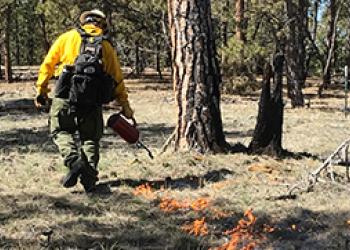Custer Gallatin National Forest Fire and Fuels Program
Mission Statement
To provide exceptional quality fire suppression, fuels treatment, and project work to the Custer Gallatin National Forest and Wildland Fire Operations. And to develop and sustain an organization comprised of professional, progressive, and determined firefighters that are individually capable and dedicated to their team.
The Custer Gallatin fire and fuels program is spread across seven Ranger Districts in two states and supported by two interagency dispatch centers. All Districts, other than Gardiner, have fuels program personnel ranging from Fuels Specialists to Assistant Fire Management Officers – Fuels to Fuels Technicians. The forest also supports a smokejumper base and a rappel base.
- Bozeman Ranger District - Bozeman, MT: Two Type 6 Engine Modules, Fuels Crew
- Hebgen Lake Ranger District – West Yellowstone, MT: Two Type 6 Engine Modules
- Yellowstone Ranger District – Livingston, MT: Two Type 6 Engine Modules
- Yellowstone Ranger District – Big Timber, MT: One Type 6 Engine Module and one Wildland Fire Module Type 2
- Gardiner Ranger District – Gardiner, MT: No modules
- Beartooth Ranger District – Red Lodge, MT: Two Type 6 Engine Modules
- Ashland Ranger District – Ashland, MT: One Type 6 Engine Module staffed by fuels personnel
- Sioux Ranger District – Camp Crook, SD: One Type 6 Engine Module staffed by fuels personnel
- Supervisor’s Office – Shenango, MT: Helicopter Rappel Program
- Supervisor’s Office – West Yellowstone, MT: West Yellowstone Smokejumper Base
The Custer Gallatin National Forest is comprised of a wide variety of terrain and fuel types that dictate wildfire response. The western portions of the forest are steep, rugged mixed conifer and lodgepole forests often in Wilderness or roadless where most responses are by smokejumper, rappel, or hiking. The eastern portions of the forest are primarily rolling hills of Ponderosa Pine and grass that are conducive to responding by engine.
The Forest is also part of an interagency fire organization that provides support to local, regional, and national incidents. The forest supports these efforts with engine modules, interagency type 2 hand crews, smokejumpers, rappelers, and single resources. In addition to helping incidents accomplishing their objectives, wildland fire response provides employee development and strengthens crew cohesion. This benefits employees and the agency by creating well- rounded firefighters and a more dynamic workforce. This can vary from experiencing life on a handcrew to venturing out on a single resource assignment or joining an Incident Management Team.
When not on fire assignments or in training, all crews are engaged in project work. The majority of project work revolves around fuels treatment: thinning, slashing, and preparation for prescribed fire. In addition, crews work with other resource areas across the forest to help them achieve their program goals. This work includes: fencing, trail maintenance, facility maintenance, and other projects as needed. This is done to help the districts that support our program.
Firefighters come in a variety of forms including: smokejumpers, engine crewmembers, helitack, and hotshots. Each fills a particular niche, but the arduous nature of firefighting places a common demand of exceptional physical fitness on all. Consequently, physical fitness is a priority for the Custer Gallatin fire program. An hour out of each day is dedicated to Physical Training (PT) when not on fire assignments.
The PT program is designed to build both physical and mental stamina through a regimen of challenging exercises. On an individual level, the PT program reduces the risk of injury, builds self-esteem, and increases confidence. It also builds team cohesion via a group format. Increased physical fitness and crew cohesion provide for an increased margin of firefighter safety.
Each employee is required to pass the pack test. The pack test is a 3 mile walk, carrying 45 pounds, in 45 minutes or less. Successful completion of the pack test is a condition of employment.
*A PT test will be administered to all employees within the first few days of work. Show up to work able to complete these minimums and the pack test.
Each firefighter is also recommended to reach a fitness goal of 1.5-mile run in 11 min or less, 7 pull-ups full extension, 25 push-ups in 1 minute, and 45 sit-ups in 1 minute as minimum. Smokejumpers are required to do 7 pull-ups/chin-ups, 45 sit-ups, 25 push-ups, and a 1.5 mile run all in less than 11 minutes at a minimum, and able to carry 115lbs+ on a long hike out.
Prescribed Fire and Fuels Management

Details about how the Forest uses prescribed fire to improve forest health and protect local communities from extreme wildfires.
A Better Way to Think About Wildland Fires
This video explores what makes fire in the West unique, and demonstrates the importance and benefits of healthy fire to forest ecosystems.


